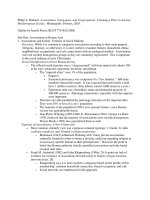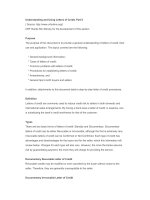Tài liệu Golf and the game of leadership 14 pptx
Bạn đang xem bản rút gọn của tài liệu. Xem và tải ngay bản đầy đủ của tài liệu tại đây (210.84 KB, 10 trang )
120
Golf and the Game of Leadership
The Professional
A human resource (HR) professional was directly responsible to
the CEO for the management of the progression and succession
planning of senior company executives. She handled the charting
and updating for the CEO, served as an information source, and
played devil’s advocate in their discussions. This function was ob-
viously ‘‘top secret.’’ Only the CEO and the HR professional knew
the details of the plan.
The HR professional did not report directly to the CEO in
matters other than progression and succession. Her boss did re-
port directly to the CEO and was responsible for several functions,
including HR. His competence level in HR lagged well behind his
confidence level, or in this case his ego. Further, he was obviously
a person who had to be considered in the progression and succes-
sion planning process. Yet he thought that he and not his subordi-
nate should be handling the process. He outwardly expressed his
displeasure with her involvement and constantly pressured her
for information contained in the plan. She steadfastly kept her
confidence with the CEO. Her boss, in turn, reflected in his ac-
tions a lack of confidence in his ability to compete fairly with his
peers as well as a lack of confidence in the CEO and his own HR
person to professionally manage a very important and delicate
process.
Yes-Man
The decision had been made to get rid of a product that was not
performing to expectations. One manager, Roberts, believed a
joint venture with another company to develop the market for the
product was a better option. So, she convinced the CEO to look
at the idea together with Adams, the manager in charge of the
product in question. The CEO, however, said, ‘‘Adams won’t
really help us.’’
The CEO then scripted how the meeting should go. He would
initially oppose continuing the product and Adams would agree.
Then Roberts was to express the joint venture idea and the CEO
would seem to support it. And Adams would agree.
10589$ CH10 02-23-04 16:45:13 PS
121
‘‘Big Bertha’’:Confidence
When the meeting was held, Adams reacted exactly as the
CEO predicted. The CEO had read him perfectly. Adams was a
pure yes-man without confidence in his own competency.
Situations similar to the Professional and the Yes-Man occur
all too frequently at all organization levels. They are the result of
undeveloped leadership competence and resulting lack of confi-
dence.
Perfect Practice
Unconscious leadership competence may be difficult to attain, but
it should be the goal of every leader. Golfers, even Tiger Woods,
need and seek help to achieve and maintain the highest level of
competence.
Claude ‘‘Butch’’ Harmon is Tiger’s coach at this writing. Ac-
cording to Harmon, as quoted in a Newsweek magazine article,
‘‘the toughest challenge is what’s between the golfer’s (substitute
leader’s) ears. It’s crucial to have someone skillful teach you right
from wrong. Practice makes permanent. It’s perfect practice that
makes perfect.’’
3
Leaders need help in developing their competence, and thus
their confidence, whether they are leadership ‘‘Tigers’’ or, like
most of us, just struggling to do our best. There is help out there
provided we have the humility and courage look for it. And it
won’t cost hundreds of dollars an hour to get it! Seek out people
whose opinions you respect, counsel with people who want you
to succeed as a leader, study and learn from people who approach
leadership differently from you but who are viewed as effective
and respected leaders, and ask other associates in your 360-degree
sphere of influence for their perceptions of your leadership effec-
tiveness.
Many golf jokes refer to God’s and/or the Devil’s intervention.
There will be no divine, or devilish, influence to grant you the
competitive leadership edge of competence and confidence. It will
only come through awareness of what is, and what is not, impor-
tant to the pursuit of leadership effectiveness, knowledge of how
10589$ CH10 02-23-04 16:45:13 PS
122
Golf and the Game of Leadership
you are perceived as a leader, and perfect practice of the funda-
mentals. Next we’ll tee up performance expectations.
Serenity [confidence] is knowing that your worst shot is
still going to be pretty good.
Johnny Miller, 1973 U.S. Open champion, NBC-TV golf analyst
Quick Tips for Improving Your Leadership
Game
Real leaders typically understand and model the following in their
day-to-day actions:
■
Do what’s right because it’s right.
■
If you make a mistake, admit it.
■
Trust your associates to take the next step. Send a clear
message, ‘‘You can do it.’’
■
Make sure your associates know what to do, know how to
do it, and have the necessary skills and resources. Then
have faith it will be done.
10589$ CH10 02-23-04 16:45:14 PS
5
11
Performance
Expectations
Over the years, [Annika Sorenstam] has developed a
simple philosophy. She will not show up for a
tournament unless she thinks she can win it.
1
Michael Bamberger, Sports Illustrated
Stevie Wonder and Tiger Woods meet and are discussing their
careers. Woods asks Wonder, ‘‘How’s the singing career
going?’’
Stevie replies, ‘‘Not too bad. How’s the golf?’’
Tiger answers, ‘‘Not too bad. I’ve had some problems with
my swing but I think I’ve got it taken care of now.’’
Stevie says, ‘‘I always find that when my swing goes wrong,
I need to stop playing for a while and not think about it. Then
the next time I play it seems to be all right.’’
Tiger exclaims, ‘‘You play golf?!’’
123
10589$ CH11 02-23-04 16:45:10 PS
124
Golf and the Game of Leadership
Stevie replies, ‘‘Oh, yes, I’ve been playing for years.’’
‘‘But you’re blind!’’ Tiger says. ‘‘How can you play golf if
you can’t see?’’
And Stevie replies, ‘‘I get my caddie to stand in the middle
of the fairway and call to me. I listen for the sound of his voice
and play the ball toward him. Then, when I get to where the
ball lands, my caddie moves to the green or farther down the
fairway and again I play the ball toward his voice.’’
‘‘But, how do you putt?’’ asks Tiger.
‘‘Well,’’ says Stevie, ‘‘I get my caddie to lean down in front
of the hole and call to me with his head on the ground and I
just play the ball toward his voice.’’
Tiger asks, ‘‘What’s your handicap?’’
And to Tiger’s amazement, Stevie replies, ‘‘Well, I’m
proud to say I’m a scratch golfer. (A scratch golfer is one
whose handicap is zero. Expect him to shoot par for the
course.)
An incredulous Woods, says, ‘‘We’ve got to play a round
sometime.’’
‘‘Well, people don’t take me seriously,’’ Wonder replies,
‘‘so I only play for money, and never play for less than $10,000
a hole.’’
Tiger thinks about it and says, ‘‘OK, I’m game for that.
When would you like to play?’’
Stevie says, ‘‘Pick a night.’’
Golfers want to be able to keep score. They want to keep track
of how they’re doing. They do not want to play in the dark! The
rules of golf require accurate scorekeeping. Every golf course has
established expectations for each hole on the course. The expecta-
tions are clearly specified on the scorecard. The golfer knows how
he or she is doing with each stroke.
Performance expectation and actual performance are clear to
all. Golfers try to do their best. The results of their efforts are not
at all subjective.
Leaders want to be able to keep score as well. So do their
followers. In order to keep score in the leadership game, it is im-
10589$ CH11 02-23-04 16:45:11 PS
125
Performance Expectations
perative that all players be clear about their performance expecta-
tions. They need to know, and understand, the expectations. They
also need to know how to achieve them, how they will be mea-
sured, and the benefits of achieving them. Hopefully, they will
agree with the expectations, but in any case they should know the
consequences of not meeting them.
Education at Its Best
Years ago I had the pleasure of introducing the noted author and
consultant Dr. Ken Blanchard to a group of Owens-Illinois execu-
tives and managers. As part of his commentary, Ken told of his
early teaching experiences as a university professor. He indicated
that his teaching practices were the subject of consternation
among the faculty.
Dr. Blanchard proceeded to tell us that on the first day of class
he would hand out the final exam and clearly indicate to the class
that the exam contained what they needed to learn from his
course. If they showed up for class, paid attention, and took notes,
they would be able, each and everyone, to get an ‘‘A’’ for the
course. And it was his objective that they would all get an ‘‘A.’’
Well, as you might expect, Dr. Blanchard’s students did very well.
This violated the faculty belief in the necessity for a normal distri-
bution of grades!
What was Ken Blanchard doing when he handed out the final
exam on the first day of class? He was setting expectations for
himself and each member of the class. He was saying, ‘‘My job is
to teach. Your job is to learn. I expect to do my job and expect
you to do yours. At the end of the semester, if you get an ‘‘A’’ we
will both be successful.
Fast Start?
You may remember the ‘‘values’’ message sent by managers with
the Blessing/White Fast Start program mentioned at the 6th hole.
The message was that in two-thirds of the eighty to ninety of the
cases I have observed, managers were unwilling, unable, uncaring,
10589$ CH11 02-23-04 16:45:11 PS
126
Golf and the Game of Leadership
unbelieving, or just too lazy to prioritize the opportunity to sup-
port their new associates getting off to a good start. The principal
objective of the Fast Start program is that ‘‘participants clarify the
purpose of their group and individual performance expectations
early on.’’ A person new to the game of golf needs some basic help
in getting started. So do you as a leader. So do your followers. If
you go out and start hitting golf balls when you’ve never done it
before and don’t know what you are expected to do, you probably
won’t do very well. Why wouldn’t you think you’d get a similar
result if you don’t meet your leadership responsibility of establish-
ing performance expectations for your followers? And while we’re
here, what agreed-upon understandings do you have with your
manager regarding your performance expectations? If you have
any questions about what is expected of you, take a break from
reading and go talk to the boss!
In my experience, a major failing of organizational leaders lies
in not providing people a clear understanding of what is expected.
And if they do, they often do not offer help in how to meet expec-
tations. Further, they do a poor job of specifying how perform-
ance to expectations will be measured. If the expectation is not
clear, the measurement cannot be specified. Hence outcomes are
unpredictable. I attribute this failing of leadership to the leader’s
lack of a disciplined approach to establishing performance expec-
tations. The result is one of serendipity best described by the often
repeated, and variously attributed, ‘‘If you don’t know where you
are going, any road will get you there.’’ Several examples come to
mind.
No How
The plant manager calls a meeting of all supervisors to dis-
cuss an across-the-board cost reduction of 10 percent. The
plant manager explains that times are tough, sales are
down, and central office is putting the pressure on opera-
tions to reduce expenses. Deadline for submitting the
plant’s schedule of reductions is one week from today. The
reduction is to include a 10 percent reduction in head
count.
10589$ CH11 02-23-04 16:45:11 PS
127
Performance Expectations
The plant manager then asks, in the same not-so-conversa-
tional tone in which he has conducted the meeting, ‘‘Are
there any questions?’’ There are none. People leave the
meeting and in the hallway are heard to comment, ‘‘And
just how the (expletive deleted) are we supposed to do
this?’’
Not in These Playing Conditions
Over the previous twenty years, quality had not been a pri-
ority. Business was good and the product seemed to be
okay. But now the competition was putting pressure on
sales, and the market was making a big deal out of prod-
uct quality. So, company management and the union
concluded that quality had to become a priority. A lot of
pronouncements from the top, poster campaigns, and a
big ad campaign followed, emphasizing the company
dedication to producing quality products.
The new emphasis worked well during forty-hour weeks.
However, when Saturday and Sunday overtime was re-
quired, which was most weeks, the emphasis fell by the
wayside. Saturday and Sunday work required the equaliza-
tion of overtime hours within the total hourly workforce. This
was required by the union-management contractual
agreements. An employee could have up to thirty hours
more overtime than other employees but at that point
could not work until the hours were equalized. As a result,
assemblers, machine operators, and skilled trades from
across the plant were mixed together to continue week-
end production. Uppermost in the mind of management
was the amount of weekend production that could be ac-
complished. So, come Monday morning the questions
asked related to numbers of units and not product quality.
The best production numbers were always on the week-
ends. Unit numbers were always up at least 10 percent over
weekdays. Quality inspectors passed everything. Poor
quality couldn’t be traced due to the make-shift crews.
10589$ CH11 02-23-04 16:45:12 PS
128
Golf and the Game of Leadership
Everyone in the plant knew what was going on. The quality
posters hung from the walls seven days a week. Leadership
did not walk-the-talk.
The Calendar Says Meet
Many organizations conduct regularly scheduled meetings. In the
university environment, I was obliged to attend a weekly dean’s
council meeting. As in the previous example, where employees
met weekly to discuss quality issues—and probably not unlike
similar activity in your organization—there were established
agendas. The meetings had been conducted on a particular day,
at a particular time, for years. The meetings were the performance
expectation. If you met regularly on Tuesdays, and something
happened on a Wednesday, you had to wait until the next Tuesday
to get together with the group. ‘‘Meet when needed’’ was not the
performance expectation.
Can You Be Trusted?
Leaders often hinder their followers’ success by simply not placing
trust in them. These leaders would not do well in Las Vegas. When
I ask groups of leaders the question, ‘‘Can you be trusted?’’ the
response is always an emphatic, ‘‘yes.’’
When I ask, ‘‘Can your people be trusted?’’
‘‘Well, mostly.’’
‘‘What do you mean, mostly?’’
‘‘Mostly’’ comes out at 90 percent or higher. If this is true, or
even if it is a lesser percentage, say 75 percent or even 60 percent,
why do so many leaders expect their followers to earn their trust?
Seems to me, with these percentages or ‘‘probabilities,’’ the bet-
ting leader should follow the advice of the ancient philosopher,
Lao Tzu, ‘‘Trust first, trust is in the giving.’’
The best way for the leader to influence trust is to give it and
then observe how it is respected by his or her followers. While it
is common sense for the leader to give trust, it is also imperative
to recognize that the leader must constantly earn the trust of those
10589$ CH11 02-23-04 16:45:12 PS
129
Performance Expectations
who follow. Clear and mutually understood performance expecta-
tions and agreed upon measurements are key to the issue of trust.
Pre-Shot Routine
All good golfers have a pre-shot routine. Many are so tuned to
their routines that if interrupted, they will stop and begin the
routine process over again from the beginning. Leaders can bene-
fit from this type of habit. The responsibility for developing per-
formance expectations lends itself to the development of a pre-
shot routine. A well-thought-out routine, learned and developed
through practice and repetition, and practiced consistently in situ-
ations involving the establishment of performance expectations,
will greatly enhance the follower’s opportunity for success and
thereby the leader’s. The following is such a routine. It has been
recommended in leadership development programs for years.
■
Step One: Describe the task in terms of major outcomes
and how it fits into the big picture of organizational outputs,
goals, and objectives. What, specifically, is to be accomplished.
■
Step Two: Agree on measurable criteria for determining
that expectations are being met. Emphasize both agreement and
measurable. Identify what specific measurements will indicate suc-
cess.
■
Step Three: Mutually identify the necessary skills, resources,
and guidelines required for expected performance. Specify how
the performance expectations can be met and what help will be
necessary to succeed.
■
Step Four: Determine the priorities for action. In order to
WIN, you need to do What’s Important Now.
■
Step Five: Review steps one through four to ensure under-
standing and commitment. Not a head-nodding to your review;
let them do it.
■
Step Six: Set a date to review progress. Leave the door open
to provide help when necessary.
10589$ CH11 02-23-04 16:45:13 PS









